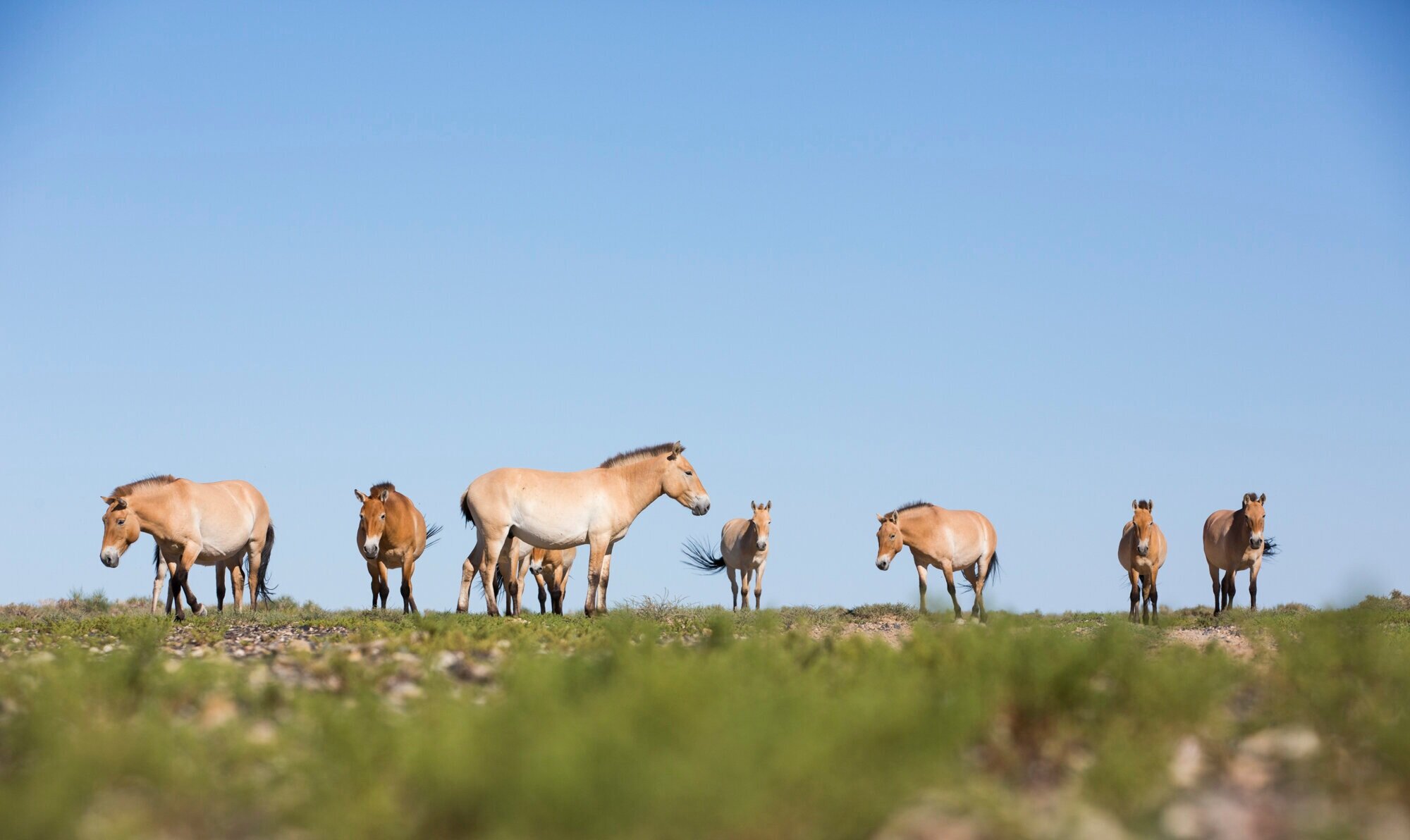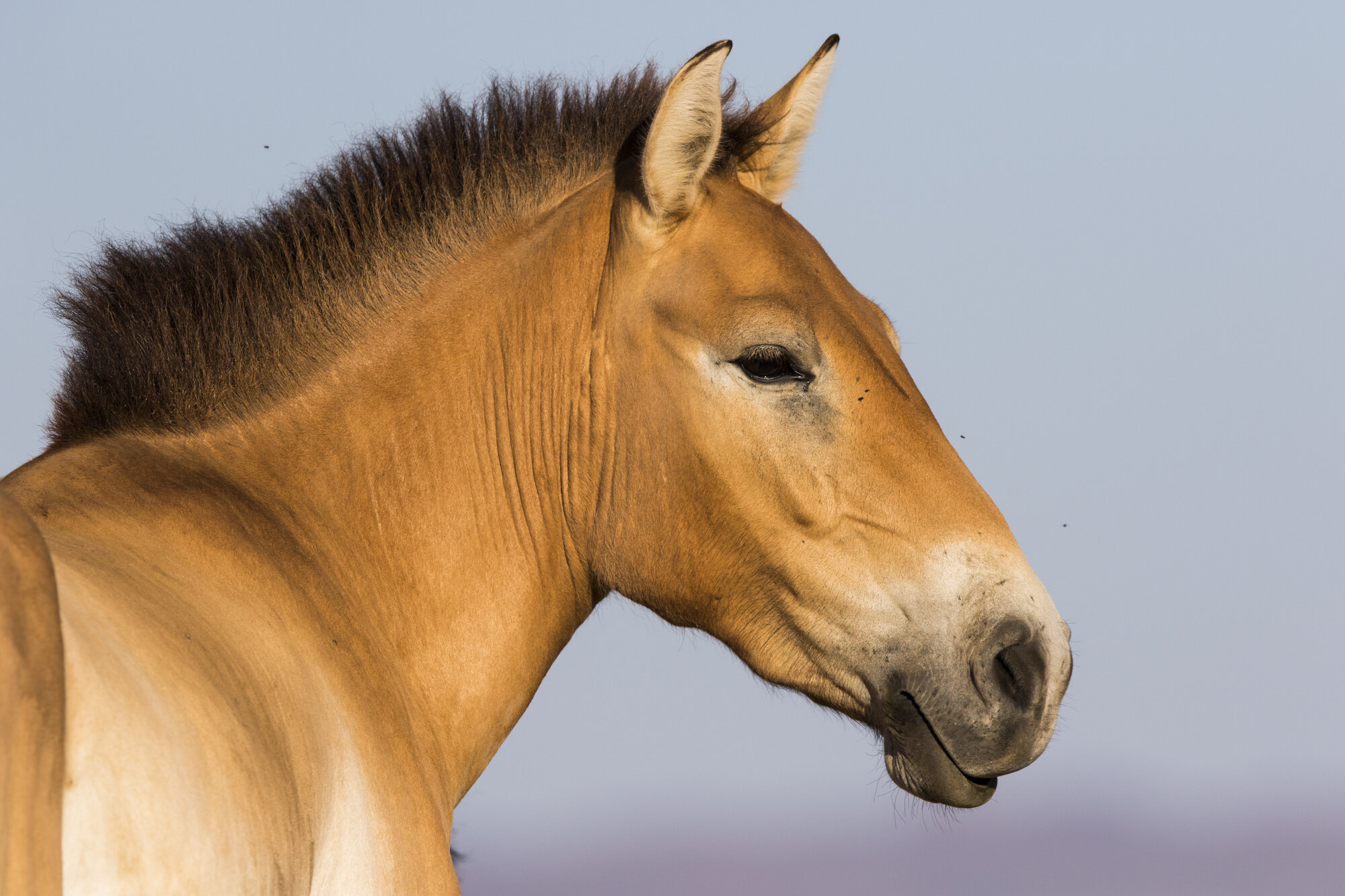
The Reintroduction Story of the Takhi
HOW THE WILD HORSE WAS RETURNED TO THE WILD 20 YEARS AFTER ITS EXTINCTION
The takhi, or Przewalski’s horse, is the only remaining wild horse species. They were once prolific on the steppes of eastern Russia, eastern Kazakhstan, western Mongolia and northern China, but experienced a continuous population decline and were last seen in the wild around 1969. In an ironic twist of fate, the Western World, which hunted the species in Asia for the exhibition in European zoos, would ultimately save the takhi.

Takhi have a reddish-brown coat with a light belly, a white muzzle and an erect dark mane. (C. Ruoso)

Takhi are native to eastern Kazakhstan, western Mongolia and northern China. (C. Ruoso)

Horses play an important role in the culture of Mongolia. (C. Ruoso)

All takhi alive today are descended from 12 individuals. (C. Ruoso)
The fall of the takhi
The takhi became widely known to Western science in 1881 when Russian explorer Colonel Nikolai Przewalski returned from an expedition in Asia with the skull and hide of a takhi. Over the next few decades, Europeans frequently returned to Mongolia to capture takhi for display in zoos. Adults however proved difficult to capture so wildlife merchants resorted to taking the foals, sometimes killing adults. Many foals were captured, but only 53 made it back to Europe alive.
Due to a combination of climatic changes, pasture competition and hunting during the first half of the 20th century, the population continuously declined and the takhi was officially declared extinct in the wild in 1969.
Early conservation efforts
Only a handful of Takhi brought to Europe through capture expeditions lived and bred in zoos when the species disappeared in the wild. Many of them died during World War II and the population dropped to 31. By the 1940s, only 12 fecund animals remained. All takhi alive today descend from those 12 takhi and one domestic horse. In 1958, a studbook was assembled, and conservation groups began planning the recovery of the species. By 1965, 134 horses lived in 32 zoos and private parks and, by the early 1990s, the species rebounded to over 1500 individuals.
Reintroduction
Thanks to the European Association of Zoos and Aquarias (EAZA) ex-situ programme, led by Prague Zoo today, as well as the coordinated efforts of the International Takhi Group and the International Union for Conservation of Nature (IUCN), takhi roam the steppes of Mongolia and China once again.
Reintroductions efforts in Mongolia began in the early 1990s when sufficient animals were available for release and when the political climate in Mongolia, after the collapse of the Soviet Union, became favorable to cooperative wildlife conservation efforts. From 1992 to 2004, animals were regularly transported by air from European zoos to the Great Gobi B Strictly Protected Area in Mongolia, where takhi were last seen in the wild. Horses are kept in an acclimatization enclosure (i.e. soft release pen) that allows them to recover from transport and to adjust to the local environment before being released to the wild. In 2011, Prague Zoo reinvigorated the population reinforcement efforts and yearly takhi releases into the Great Gobi B Strictly Protected Area for several years.
Today, takhi are also found in semiwild reserves in France, Ukraine, Hungary, Uzbekistan and in the unfenced Chernobyl exclusion zone in Ukraine.
From 1970 to 2008, the IUCN reclassified the species twice from "extinct in the wild" to “critically endangered” to "endangered".
In 2000-01 and 2009-10, a dzud, a severe weather phenomenon in Mongolia that causes dry summers followed by frigid winters with a deep compact snowpack, occurred. In 2010, it killed 89 of the 137 takhi in the Great Gobi B Strictly Protected Area in Mongolia. Source: ITG International Takhi-Group
Lessons learned
Having multiple projects is beneficial
The takhi releases in Mongolia are managed by organizations in 3 separate reserves (i.e., Great Gobi B SPA, Hustai Nuuru National Park, Khomin tal). Having separate projects allows the organizations to compare approaches and to share knowledge and experiences.
Genetic management is critical
Managing genetics from the onset of a conservation breeding program is key to minimize inbreeding, avoid hybridizing with domestic animals and ultimately maintain a healthy breeding population in the long-term.
Capture and transport methods have evolved over time
New techniques, including the use of novel anesthetic protocols and improved crate designs, have greatly enhanced the welfare of takhi during transport to release sites.
Success of releases can improve over time
In the early days, the newly reintroduced takhi struggled because of predation by wolves and natural disasters called dzuds. Much was learned from each release, and release protocols were modified to reduce post-release mortality.
Health monitoring is essential
In the beginning, many takhi would die in the first spring following release. Rigorous health sampling and testing quickly determined they were dying of babesiosis, a disease caused by a blood parasite transmitted by ticks. The parasite is endemic to Mongolia and, while the native horses were immune to it, the takhi imported from Europe were not. Health protocols were adjusted and deaths due to Babesia infection were prevented. Visual health monitoring carried out by the rangers of the Great Gobi B SPA continues today.
Captive-born takhi can adapt to living in the wild
In the early years of the reintroduction efforts, there were concerns that takhi born in captivity would not know how to fare in the wild. In the beginning, released takhi tended to stay near the release site. However, over the years they proved to be able to find the most nutrient-rich forage plants, to enlarge and adjusted their range seasonally and according to weather, escape predators and deal with dangers. Translocated horses aren’t as wary of humans as wild ones once were, but their foals are.
Fun facts
Takhi symbolize Mongolia’s national heritage and culture.
Takhi, which means "spirit" or "holy" in Mongolian, are considered the riding mounts of the Gods in Mongolian folklore.
Takhi use their sharp hooves to dig the ground in search of water in their dry habitat.
Prehistoric cave paintings in Spain and France feature sturdy ungulates that closely resemble the takhi.
Takhi replace their short-haired summer coat with a long-haired one with very thick sub-wool in the winter.
Takhi usually shed their coat all at once whereas domestic horses shed their coat progressively.
Takhi carry 2 more chromosomes than the domestic horse.
In August 2020, the world’s first successfully cloned takhi was born. The foal, born to a domestic surrogate mother, is a clone of a male takhi whose DNA was cryopreserved 40 years ago at the San Diego Zoo Global Frozen Zoo®.
Recommended Readings
Birth of Cloned Przewalski’s Foal Offers Genetic Diversity for This Endangered Species (San Diego Global, 2020)
The Last Truly Wild Horses Are Alive and Well in Chernobyl (Popular Mechanics, 2019)
The Mongolian Takhi: Honoring the Spirit Horse (US Represented, 2019)
The Remarkable Comeback of Przewalski’s Horse (Smithsonian Magazine, 2016)
10 Things You Didn’t Know About Przewalski’s Horses (Scientific American, 2014)
Przewalski's Horse: The History and Biology of an Endangered Species (1994)



